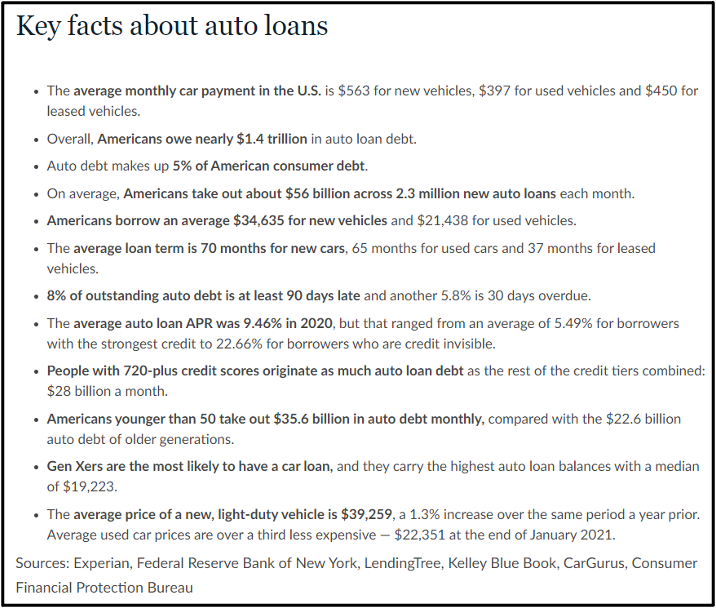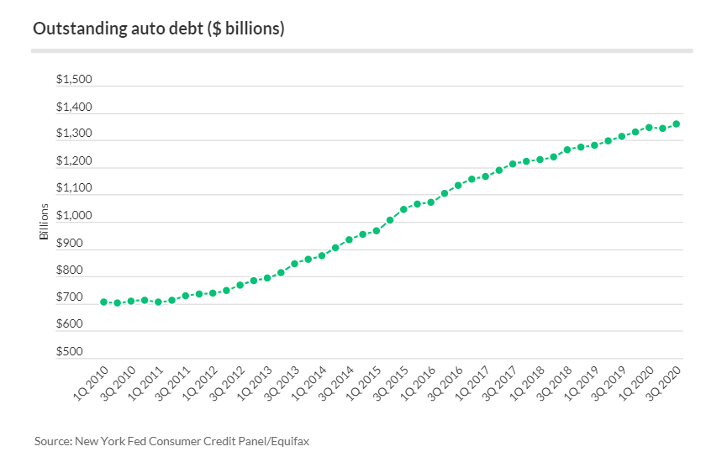I have discussed some of the unusual supply chain issues
over the last several posts. It is a very strange time we are living in for
sure, but what has struck me lately is how a little wrinkle in a supply chain
affects so many things that I never thought of. Automobiles are particularly
sensitive to these interruptions. As such, just trying to rent a car while on
vacation suddenly has become an adventure. As discussed in my June 15th
post "Something
(Not) in the Water," prices for used cars have shot up over 7% in just one
month. New autos are hard to find and some lots look like they have been
stripped bare of vehicles. Producers can't get chips, and since we now drive
rolling computers, they can't get new cars off the line fast enough. Having
personally been affected by these imbalances, I thought I should probably get
an expert to comment on the lending side of this conundrum.
Jim Toliver has been working in the bank and credit union space for almost three decades and has been a heeded voice in auto lending over the last several years. I wanted to get his take on what is currently happening in the world of auto lending. Warning: this is a technical topic which obviously can't be fully covered in a short blog post! Please reach out to Jim directly with more specific questions.
Kurt: Jim,
in 2018 you were very critical of the auto lending environment. In fact,
you wrote papers and held talks telling people not to make auto
loans. What's changed in the last 3-4 years?
Jim: As Treasury and wholesale funding rates increased between 2014-2018, auto loan rates moved only a fraction of this amount, and so the spread between the national average new auto rate and wholesale funding compressed from 2.50% to 1.05%. After adjusting for acquisition and servicing costs, disregarding credit risk, returns were well through Treasury rates.
Since this time, Treasury and wholesale funding rates have fallen materially while national average auto loan rates have drifted higher. The spread between the two rates today is 3.80%. This is an improvement over the 2018 market condition, which had a spread more like 2.75%. Net of acquisition costs, servicing costs, and even applying credit losses like those we saw in 2007, today we would still be left with a positive spread of 0.65% over funding. So yes, a big change since 2018.
So, you have a clear vision for why things have improved. Why was it so difficult for people to see the shortfalls in the 2018 era? Is auto lending really that changeable?
There are a few dynamics you must keep an eye on to ensure program profitability through interest rate cycles. As you have discussed in your blog in the past, we need to be looking at our decisions over time and across different interest rate scenarios. Managers who practice this discipline are very familiar with comparing unlike cash flows on a level playing field and developing strategies based on this disciplined process.
Unfortunately, people who rigorously apply such disciplined processes in the investment portfolio sometimes ignore these same disciplines when they turn to the loan portfolio.
Unfortunately, people who rigorously apply such disciplined processes in the investment portfolio sometimes ignore these same disciplines when they turn to the loan portfolio. Within this group, the error in the 2018 environment spot was to use cost of funds as their measure, rather than using funds transfer pricing. As Treasury and wholesale funding rates increased significantly, loan rates and their cost of funds rose only a fraction of the move. Those who showed discipline identified how irrationally priced indirect auto loans had become and chose to pursue investment strategies or other lending opportunities superior to generic indirect auto lending. The less disciplined group never recognized or reacted to this turning point.
What was the turning point? As Treasury and wholesale funding rates rose much further than auto loan rates or their cost of funds did, the value of institutions' deposit bases grew, and so the relative value of auto loan programs fell. The technical exact turning point is the point at which funds transfer pricing reveals that an institution's deposit base profitability is subsidizing auto lending. You couldn't see this by looking only at cost of funds.

Chairman
Powell specifically mentioned the auto market as a source of transitory
inflation. I mentioned the crazy cost of rental cars a few weeks ago, and
I have to believe that current high inflation might impact loss
expectations. Do you have any thoughts on this?
Definitely. This is a good news/bad news story: I like what I see in the rearview mirror, but I don't like what I see through the windshield. With all the financial stimulus that accompanied the pandemic, we find ourselves with loan deferments at pre-pandemic levels and with very low auto loan delinquencies. Making this news even better, the recovery rates that drifted down around the 60% level pre-pandemic are now as high as 110%! But that is all a result of what has happened - the rearview mirror.
Chairman Powell has referred to the used auto market as an example of transitory inflation. Deferred and recovering demand, supply shortages due to production constraints and just-in-time inventory management. As reflected in the recovery rate on repossessed autos rising from 60% to 110%, we have to anticipate that high LTV loans made today at these high valuation levels will be a very unique "post-pandemic vintage" of loans; we certainly cannot safely rely on continuing auto inflation to cover our recovery rates in the future and could face a "return to normalcy" making recoveries more challenging from higher initial LTVs.

Thanks for all of these insights. One last question: how would you advise managers who deal with auto loans to adjust their loss expectations? Should they be changing their underwriting standards?
Something that Alan Greenspan said decades ago has stuck with me. It is hard to make a bad loan during tough economic times. More marginal credits get exposed in such challenging environments. But during periods of prolonged prosperity, it is tough to distinguish the more marginal credit risk borrowers.
These are tough times for many, but artificialities have made them look, from a credit perspective, like prosperous times. We must underwrite loans based on earned income and not depend on any federal stimulus propping up borrowers. If we do that, I don't expect an increase in loss frequency for the post-pandemic vintage loans.
Loss severity with this vintage could tell a very different tale. Recovery rates surging from 60% to 110% suggests collateral valuations have nearly doubled. Additionally, larger loans, for affordability purposes, are often longer loans. Longer loans translate into more loans becoming undercollateralized and by greater amounts over time due to depreciation outpacing paydowns. But the real risk looming today would be a normalization in car values as supply chain issues abate. Since recovery rates are nearly double due to the values at which a car can be resold right now, we should expect the post-pandemic loans underwritten using these inflated valuations to be at risk of experiencing recovery rates nearly half of the 60% pre-pandemic recovery rates.
So, loss frequency can be managed by careful underwriting, looking at borrowers through the windshield and not the rearview mirror; loss severity can be managed through our loan terms—resisting longer terms where possible, projecting future likely LTVs in our analysis, and so on.
I am calling for discipline, not avoidance. Funds transfer pricing tells me that for most institutions, if they watch out for these credit concerns, auto lending can be quite profitable today.
I want to thank Jim for answering those questions and for being willing to discuss these ideas in even greater detail with anyone who is interested. Please feel free to shoot Jim an e-mail if you want to go for an even deeper dive into this very significant—and always changing—part of our economy. Jim can be reached at jtoliver@performancetrust.com
Just think how many cars, trucks, and motorcycles are on the road. Most of them have loans attached to them and so many of our financial institutions in the United States have exposure. I think it would be a big mistake not to keep your eyes wide open for disturbances or imbalances that can affect us all. It affected me when I was on vacation just looking for a rental car!
If you are a client of Performance Trust, Jim goes more in depth on this topic in our most recently published Disciplined Insights, which can be found on the Performance Trust portal. He discusses a quick method to assist in pricing decisions, elaborates on changes in the market conditions since 2018, provides cautionary considerations for auto credit, and concludes with actionable next steps when considering auto loans for your institution. If you are not yet a client, reach out to your Performance Trust contact.
Final, final thought: I was in Jackson Hole, Wyoming last week and I think I have finally found the perfect fried chicken at a restaurant called Gather. It is so dang good! Why can't I come close to duplicating it at home?
Be sure to fill out the form below to subscribe to my weekly blog.


